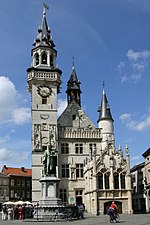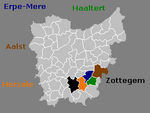Aalst railway station
Aalst, BelgiumBelgian railway station stubsRailway stations in BelgiumRailway stations in Belgium opened in 1853Railway stations in East Flanders ... and 1 more
Railway stations opened in 1853

Aalst railway station (Dutch: Station Aalst, French: Gare d'Alost), officially Aalst, is a railway station in Aalst, East Flanders, Belgium. The station opened on 9 June 1853 and is located on railway lines 50 and 82. The train services are operated by the National Railway Company of Belgium (NMBS/SNCB).
Excerpt from the Wikipedia article Aalst railway station (License: CC BY-SA 3.0, Authors, Images).Aalst railway station
Pierre Corneliskaai,
Geographical coordinates (GPS) Address Nearby Places Show on map
Geographical coordinates (GPS)
| Latitude | Longitude |
|---|---|
| N 50.945833333333 ° | E 4.0391666666667 ° |
Address
Pierre Corneliskaai
Pierre Corneliskaai
9300 (Aalst)
East Flanders, Belgium
Open on Google Maps










